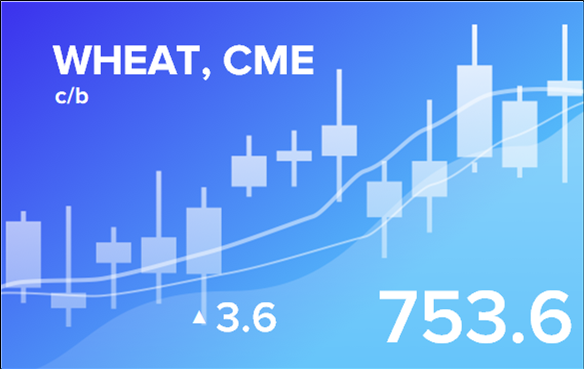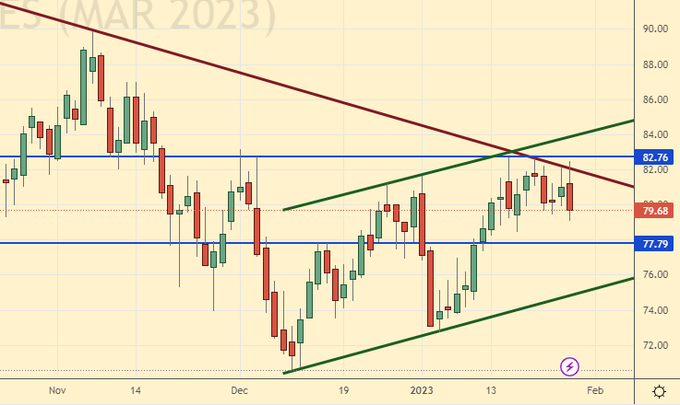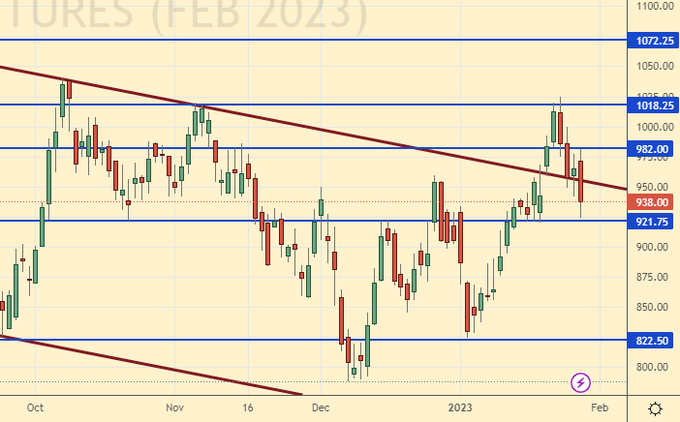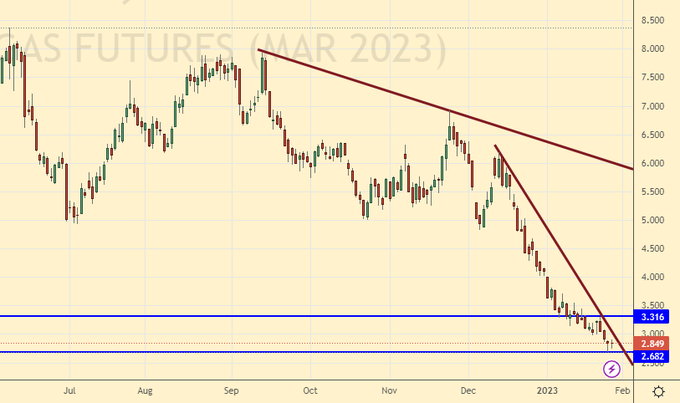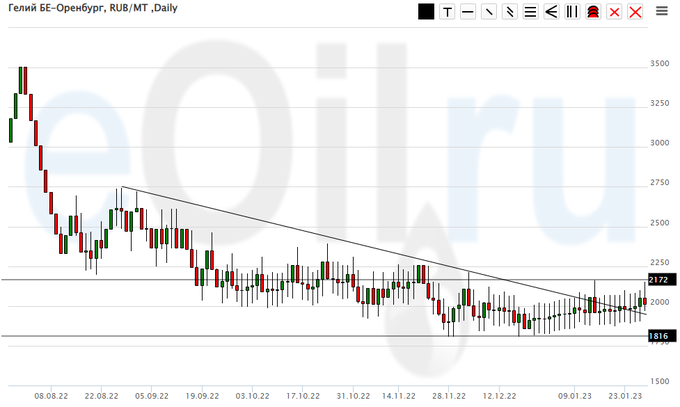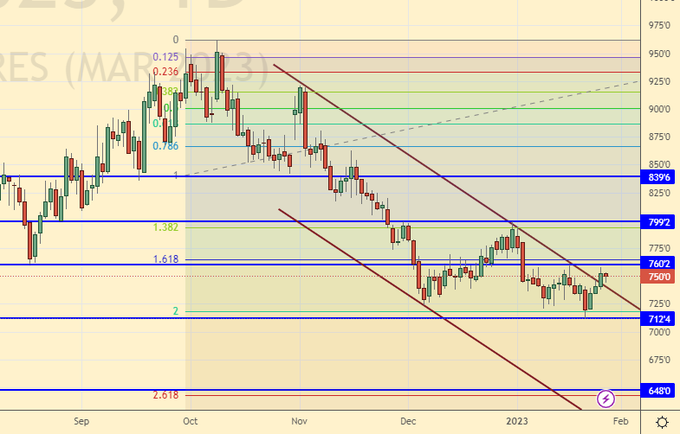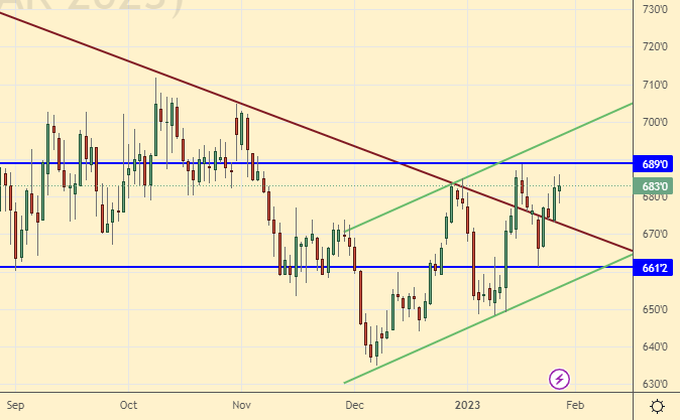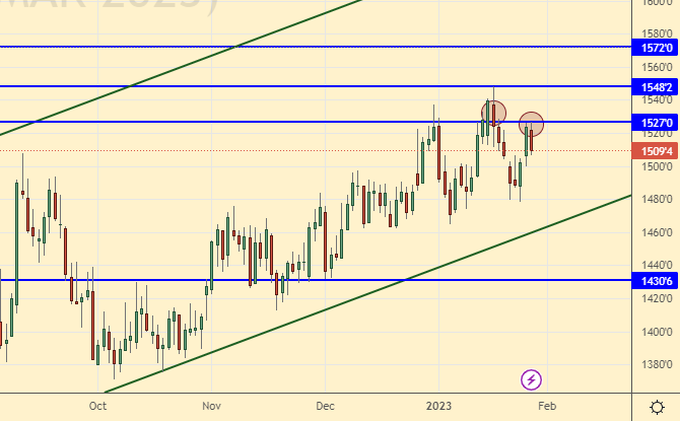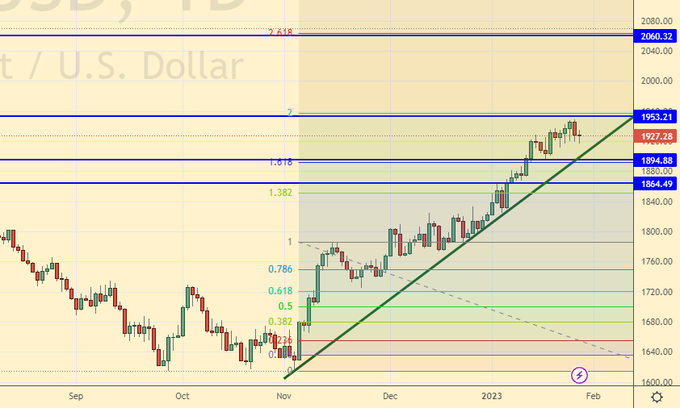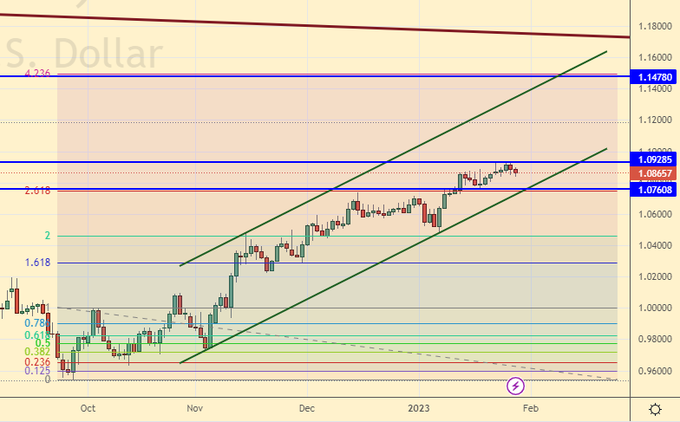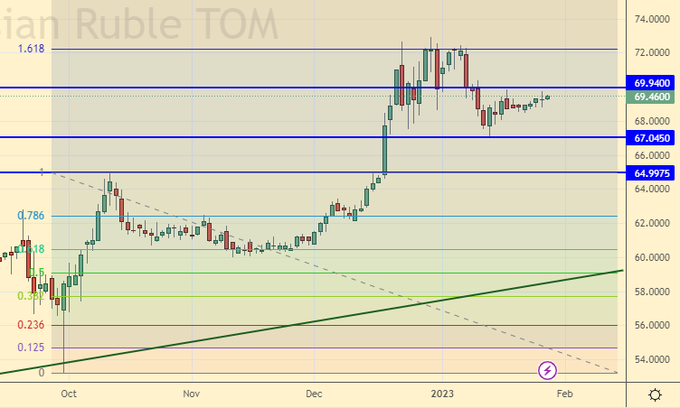Price forecast from 30 January to 3 February 2023
Grain market:
Russian oil, poured from one container to another in the middle of the Mediterranean Sea, is no longer considered Russian, it can then be sold anywhere. It’s beautiful.
Pour, pour, but know the measure. Hello!
This issue has been prepared with the direct participation of analysts from eOil.ru and IDK.ru trading platforms. Here an assessment of the situation in the world and Russian markets is given.
Prices for wheat with a protein content of 12.5% fell to 307 dollars per ton on the basis of Novorossiysk and are likely to continue to decline. At the moment, there are no prerequisites for the suspension of wheat exports from Russia, however, closer to summer they may appear, since not leaving grain in the country in a situation of confrontation with the West is an extremely risky business.
Here is a recent example. India miscalculated. The country began to experience a shortage of wheat, as part of the grain was exported as part of a project to develop foreign trade, but at the same time, domestic needs were underestimated. As a result, there is a shortage of wheat in the field and rising prices.
In the south of Kazakhstan, wheat has fallen in price to $270 per ton. The decline in prices can be primarily associated with the influx of cheap Russian wheat, which is displacing Kazakh wheat. In order to get at least some money, farmers and grain traders are forced to reduce prices, losing competition to Russian farmers.
Thus, at the moment we are extremely reserved about the prospects for growth in oil prices. The move of the Brent grade above the level of $90.00 per barrel will be considered a surprise.
Energy market:
In the US, the old-fashioned game of raising the debt ceiling has begun again. All traders are in suspense, is it a default. Is it a crisis. Don’t you dare worry. Judging by the excellent indicators of the labor market, unemployment in the United States is now 3.5%, America is very far from suicide. There is not only money, but also life. Due to this, oil prices will continue to receive support from the good prospects for the US economy. And the public debt will rise. How not to lift. It has been raised so many times before.
However, the United States alone is not enough for the whole world. The mood in the EU began to improve just a couple of weeks ago, when it became clear that there would be enough gas until the end of the winter. Prior to this, China abandoned the “zero tolerance” policy for COVID and everything seems to be fine, but no one expects strong economic growth. It has nowhere to come from, since almost all major niches are occupied, and so far one can only dream of cheap loans for the development of new directions.
USD/RUB:
On Wednesday, February 1, the US Federal Reserve is likely to raise the rate by 0.25% to 4.75%. If inflation data in America continues to show a slowdown, then it is possible that the rate will not be raised in March. Note that a rate close to 5% creates strong fundamental positions for the dollar, especially in an environment where there are not so many ideas for investment.
Next week, after the end of the Chinese New Year celebrations, the Bank of Russia is likely to resume selling yuan on the stock exchange to cover the budget deficit. The amount is insignificant. The Chinese currency will be sold for 54.5 billion rubles from January 11 to February 6, which will provide momentary support to the ruble. But we do not expect the ruble to strengthen against the dollar below 65.00 in the current situation.
Brent. ICE
We’re looking at the volume of open interest of managers. You should keep in your mind that these are data from three days ago (for Tuesday of the past week), they are also the most recent of those published by the ICE exchange.
At the moment, there are more open long positions of asset managers than short ones. Buyers control the market. Over the past week, the difference between long and short positions of managers increased by 34.3 thousand contracts. The change is significant. Buyers continued to increase their presence. Sellers retreated in approximately the same volumes. The spread between long and short positions continued to widen. Bulls are in control.
Growth scenario: consider the January futures, the expiration date is February 28. Growth has stalled. The bulls need to take the market above the 90.00 level in order for a crowd of buyers to come and prices to start rising faster.
Fall scenario: at current levels it is necessary to sell. Buyers have not yet convinced us of their strength.
Recommendations for the Brent oil market:
Purchase: no. Who is in position from 79.00, move the stop to 83.40. Target: 120.00?!
Sale: now. Stop: 88.70. Target: 55.00 (45.00?!!!) dollars per barrel.
Support — 85.50. Resistance is 88.56.
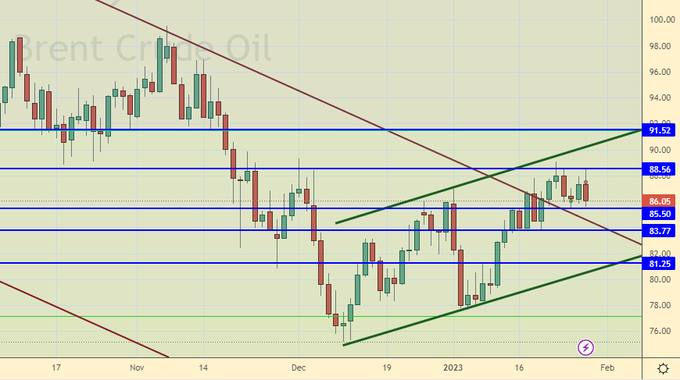
WTI. CME Group
US fundamental data: the number of active drilling rigs decreased by 4 units and now stands at 609 units.
Commercial oil reserves in the US increased by 0.533 to 448.548 million barrels, while the forecast was +0.971 million barrels. Inventories of gasoline rose by 1.763 to 232.022 million barrels. Distillate inventories fell -0.507 to 115.27 million barrels. Inventories at Cushing rose by 4.267 to 35.694 million barrels.
Oil production has not changed and is 12.2 million barrels per day. Oil imports fell by -0.956 to 5.905 million barrels per day. Oil exports rose by 0.835 to 4.707 million barrels per day. Thus, net oil imports fell by -1.791 to 1.198 million barrels per day. Oil refining increased by 0.8 to 86.1 percent.
Gasoline demand rose by 0.088 to 8.142 million barrels per day. Gasoline production fell by -0.034 to 8.831 million barrels per day. Gasoline imports fell by -0.103 to 0.453 million barrels per day. Gasoline exports fell -0.041 to 0.893 million bpd.
Demand for distillates fell by -0.146 to 3.878 million barrels. Distillate production fell -0.009 to 4.592 million barrels. Distillate imports rose by 0.172 to 0.32 million barrels. Exports of distillates rose by 0.104 to 1.106 million barrels per day.
Demand for petroleum products fell by -0.867 to 19.447 million barrels. Oil products production fell by -0.288 to 20.822 million barrels. Imports of petroleum products fell by -0.181 to 2.224 million barrels. Exports of petroleum products fell by -0.53 to 5.787 million barrels per day.
Propane demand fell -0.466 to 1.052 million barrels. Propane production fell by -0.021 to 2.375 million barrels. Propane imports fell -0.027 to 0.153 million barrels. Propane exports rose by 0.28 to 1.619 million barrels per day.
We’re looking at the volume of open interest of WTI managers. You should keep in your mind that these are data from three days ago (for Tuesday of the past week), they are also the most recent of those published by the CME Group.
At the moment, there are more open long positions of asset managers than short ones. Buyers control the market. Over the past week, the difference between long and short positions of managers increased by 4.2 thousand contracts. The change is minor. Both sellers and buyers left the market, sellers did it a little more actively. The spread between long and short positions has widened, and the bulls continue to control the situation.
Growth scenario: switched to March futures, expiration date February 21. Failed to go above 82.80. This failure could lead to a downward reversal in the market. Let’s move the stop order closer to the current values.
Fall scenario: we will continue to recommend sales. Buyers are still unable to break above the resistance line at $82.80 per barrel.
Recommendations for WTI oil:
Purchase: no. Who is in position from 74.00, move the stop to 76.30. Target: 110.00.
Sale: now. Stop: 82.80. Target: 66.00 (40.00). Who is in position from 82.00, keep the stop at 83.60. Target: 66.00 (40.00) dollars per barrel.
Support — 77.79. Resistance — 82.76.
Gas-Oil. ICE
Growth scenario: we consider the February futures, the expiration date is February 10. Can buy. But we put a stop order close.
Fall scenario: in case of a fall below 900.0, we will sell. Short from current levels is also possible.
Gasoil recommendations:
Purchase: now. Stop: 910.0. Target: 1200.0?!
Sale: after falling below 900.0. Stop: 990.0. Target: 750.0.
Support — 921.75. Resistance is 982.00.
Natural Gas. CME Group
Growth scenario: we consider the March futures, the expiration date is February 24th. Prices are extremely low. Can buy. A retracement to 3.500 is already a 25% uptrend.
Fall scenario: it makes no sense to sell. Prices have dropped. We’ll be back to shorts soon.
Recommendations for natural gas:
Purchase: now. Stop: 2.620. Target: 3.500.
Sale: no.
Support — 2.682. Resistance — 3.316.
Arctic diesel fuel (Surgut), ETP eOil.ru
Growth scenario: fixed below the level of 75000. So far, we refuse to buy.
Fall scenario: The 60000 level continues to be a good ambitious downside target. At current levels, you can add to existing shorts.
Diesel market recommendations:
Purchase: no.
Sale: now. Stop: 77,000. Target: 65,000 (60,000) rubles per ton. Those who are in positions from 84,000, move the stop to 81,000. Target: 65,000 (60,000) rubles per ton.
Support — 70322. Resistance — 79209.
Propane butane (Surgut), ETP eOil
Growth scenario: we see an extremely low offer price. You can buy. It is unlikely that in this situation there can be any significant risks. When moving to zero, you can increase the volume of purchases.
Fall scenario: there is no point in selling. Everything that could happen has already happened.
Recommendations for the PBT market:
Purchase: now. Stop: 0.00 (zero). Target: 4000.
Sale: no.
Support — 830. Resistance — 3408.
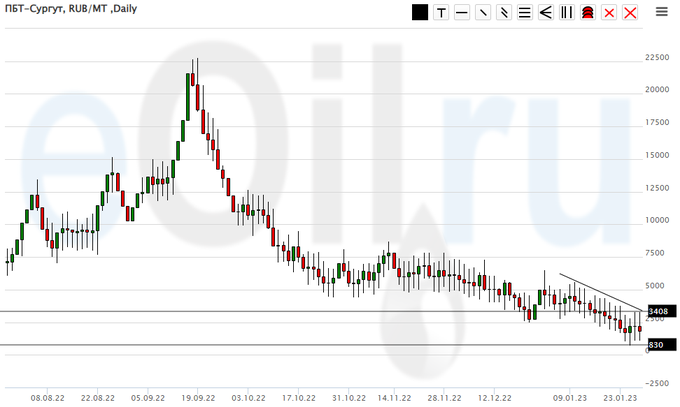
Helium (Orenburg), ETP eOil
Growth scenario: The market is trying to recover. There is a small demand. Can buy now. The target at the top remains at 3000.
Fall scenario: do not sell. Prices are extremely low.
Recommendations for the helium market:
Purchase: now. Stop: 1820. Target: 3000. Whoever is in positions between 1800 and 1900, keep the stop at 1820. Target: 3000 rubles per cubic meter.
Sale: no.
Support — 1816. Resistance — 2172.
Wheat No. 2 Soft Red. CME Group
We’re looking at the volume of open interest of wheat managers. You should keep in your mind that these are data from three days ago (for Tuesday of the past week), they are also the most recent of those published by the CME Group.
At the moment, there are more open short positions of asset managers than long ones. Sellers control the market. Over the past week, the difference between long and short positions of managers increased by 9.2 thousand contracts. Sellers entered the market, buyers did not show themselves in any way. The spread between short and long positions widened. Sellers keep the edge.
Growth scenario: we consider the March futures, the expiration date is March 14. They try to make us believe that the market will grow. But until we have passed above the level of 780.0 cents per bushel, we will not believe in continued growth. We continue to wait for the market to fall to the level of 650.0.
Fall scenario: bulls look weak so far. Yes, there is growth, but it is local. Here you can sell.
Recommendations for the wheat market:
Purchase: when approaching 650.0. Stop: 630.0. Target: 800.0. Or in case of growth above 780.0. Stop: 735.0. Target: 1200.0?!!!
Sale: now. Stop: 780.0. Target: 650.0. Who is in position from 750.0, move the stop to 780.0. Target: 650.0 cents per bushel.
Support — 712.4. Resistance — 760.2.
We’re looking at the volume of open interest of corn managers. You should keep in your mind that these are data from three days ago (for Tuesday of the past week), they are also the most recent of those published by the CME Group.
At the moment, there are more open long positions of asset managers than short ones. Buyers control the market. Over the past week, the difference between long and short positions of managers increased by 4.6 thousand contracts. The change is minor. Both buyers and sellers entered the market in small numbers. The spread between long and short positions widened. Bulls continue to control the market.
Growth scenario: we consider the March futures, the expiration date is March 14. Until we have risen above the level of 710.0, purchases will be extremely risky. Out of the market.
Fall scenario: continue to recommend shorts. We cannot rise above 690.0, and this weakness creates the prerequisites for a move down.
Recommendations for the corn market:
Purchase: not yet.
Sale: now. Stop: 698.0. Target: 590.0 (550.0) cents per bushel.
Support — 661.2. Resistance is 689.0.
Soybeans No. 1. CME Group
Growth scenario: we consider the March futures, the expiration date is March 14. We will continue to stop shopping. The bulls haven’t shown us anything in the past week.
Fall scenario: Friday’s red candle and failure to make a new high give us reason to sell.
Recommendations for the soybean market:
Purchase: no.
Sale: now. Stop: 1533.0. Target: 1000.0. Who is in position from 1500.0 move the stop to 1533.0. Target: 1000.0.
Support — 1430.6. Resistance is 1527.0.
Growth scenario: the market is held above 1920. A move to 2060 without a downward rollback cannot be ruled out. We keep long, but move up the stop order.
Fall scenario: go short if below 1920, as this move could defuse to 1800.
Recommendations for the gold market:
Purchase: no. Who is in position from 1927, move the stop to 1920. Target: 2060 (2400).
Sale: after falling below 1920. Stop: 1937. Target: $1,800 a troy ounce.
Support — 1894. Resistance — 1953.
EUR/USD
Growth scenario: so far the bulls have no problems. If so, then we keep longs and continue to wait for a move to 1.1500.
Fall scenario: considering a short entry is possible only after the market drops below 1.0700. We do not open down positions yet.
Recommendations for the EUR/USD pair:
Purchase: no. Those in positions between 1.0800 and 1.0860 move the stop to 1.0780. Target: 1.1500.
Sale: no.
Support — 1.0760. Resistance is 1.0928.
USD/RUB
Growth scenario: if the market gives an opportunity, then from 65.00 it is necessary to buy. Note that there are no strong fundamental prerequisites for a fall yet. If we go further up without a pullback, then we can enter long after rising above the level of 71.50.
Fall scenario: continue to hold shorts from 72.50 with a target at 65.60. The chances of the dollar falling, albeit small, are still there.
Recommendations for the dollar/ruble pair:
Purchase: when approaching 65.00. Stop: 63.00. Target: 83.00. In case of growth above 71.50. Stop: 69.80. Target: 83.00 (88.00).
Sale: no. Who is in position from 72.50, move the stop to 71.60. Target: 65.60 rubles per dollar.
Support — 67.04. Resistance — 69.94.
RTSI
Growth scenario: we consider the March futures, the expiration date is March 16. Almost none of the market participants doubts that enterprises will be subject to additional taxes, which will lead to the disappearance of dividends. The attractiveness of buying shares in such conditions will be extremely small. However, we can only grow on the expectation that everything will be fine.
Fall scenario: We continue to note that if the market goes below 98000, this could lead to a fast move to 90000. As expected, the 98000-99000 area provided strong support. If it is broken down, it makes sense to add it to the shorts.
Recommendations for the RTS index:
Purchase: no. Who is in position from 100000, keep stop at 97000. Target: 112000.
Sale: no. Who is in position from 106000, 103000 and 101000, keep the stop at 103000. Target: 80000 (50000, then 20000) points.
Support — 98860. Resistance — 101460.
The recommendations in this article are NOT a direct guide for speculators and investors. All ideas and options for working on the markets presented in this material do NOT have 100% probability of execution in the future. The site does not take any responsibility for the results of deals.
